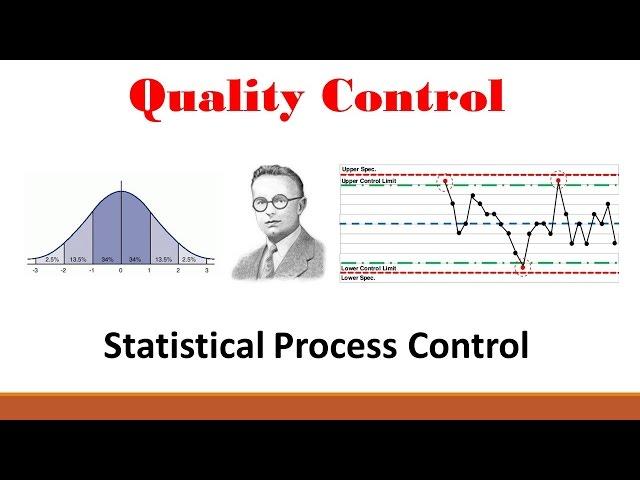
Quality (Part 1: Statistical Process Control)
Комментарии:

TY for your effort ...
Ответить
Thank you. It helped me understand.
Ответить
Well done. One problem though, Shewhart used the term “chance” to describe random “common cause” variation, not special cause. While Special, “assignable” cause can be traced to a specific change, it is not considered random variation.
Ответить
This is fantastic!
Ответить
блин надо учить английский
столько информации полезной, но на английском

Thanks a lot! One question, could a lack of variability be a sign that you are putting too many resources(time/money) in a process? It is allowed to vary more, so you are basically overachieving?
Ответить
Good explanation
Ответить
Great!
Ответить
Thank you very much, it helped me with my MBA.
Just one more request. It would be good idea if you could post video about accurate vs precise processes.

Well Done, helped me for my MBA course.
Ответить
It would have been more interesting if the Run chart at the end was described better and was derived from the data set.
Ответить
The Americans were the ones that taught the Japanese SPC after WW2 on how to make cars
Ответить
is there some sort of hypothesis testing that can be done to determine whether a "trend" actual is an out of control process or appears that way by chance?
Ответить
Surely 15 data points consecutively in centre 1/3 makes the process is more accurate and repeatable making the manufacturing more consistent?
Ответить
Great video and refresher on statistical process control! Thank you!
Ответить
Very well done overview. This is a difficult topic to cover in a short amount of time.
Ответить
When you set the rules for out-of-control conditions, how does the number of points in the rule depend on the sample size? Should i count 8 points above or below mean either for a 100 points sample and a 1000 one? Also, if I get new data into the series, should I recalculate the average? Thanks...
Ответить
Thank you! This video is great!
Ответить
Sir nice vedio but would love to know what are the different reason for these 7 out control charts and how to solove them.
Ответить
Sirr what is the solution or interpitation if control chart dont show variation with positive and negative control.
Ответить
Great Video! Thank you... Could you also explain more cases or applications of statistical processes involved in quality control?
Ответить
Points of clarifications: (1) Common Causes are random events that are inherent in the process. Special Causes are due to specific changes or events that cause variations in the process, not the other way round. (2) Any chart that displays measured data over time is called a run chart. This means that all control charts are run charts. However, when we have a control chart without the central average line and control limits are just called run charts.
Ответить
In the practical world:
1) With statistics, it always better to draw your conclusions (what ever pattern you may or may not find) from having more samples i.e. more data (more variety) = more accurate your conclusions becomes.
2) Not only investigate with production engineer & machining technician (those who make the part), it always good practice to consult your design engineer as to how the upper & lower limit were formulated, because the target value may not always be centered ("bi-lateral limit" in SolidWorks) or the upper & lower limit were deliberately biased to one side (to achieve certain fit), but some factory hated it (time factor) and so they machine to median tolerances and not bi-lateral without notifying e.g. injection mold tools & cavity or most Chinese machinist for mass production.
3) More over during NPD process , design engineers only have fewer samples to work with (smaller data set) compared to mass production where you tend to get a more accurate read (much larger data), because quite often the upper & lower limit has to be re-assessed (if it an internal component) even though it possible no changes to the production process whatsoever, which is why it a good practice to consult with "design engineers".
4) SPC + time:
Time of day can cause havoc or even seasonal (beware), because of all the heat built up during the day by all those machinery or direct sunlight shining through the windows. If this is a real problem then you should really invest in temp & moisture control environment (expensive option for some factories), just like some treating like a CMM equipment.)

What about precision and accuracy? Why is it not taken into account related to the
Ответить
Can you give me the ppt please
Ответить
Great video! very helpful
Ответить
dirt or dust in the machine
Ответить
Are you sure if the standard deviation formula is correct?
Ответить
Sorry, professor what?
Ответить
thanks
Ответить
It’s just an overview. Not in depth enough to where You could perform spc based on the video only.
Ответить
If I know there is variation, what tools do I have to try to reduce/control it?
Ответить
Excellent overview, thank you
Ответить
Thank you for this video
Ответить
Could you please recommend me best book for statistical quality control.
Ответить
I'm having a bit of trouble understanding why "lack of variability" (15 or more consecutive points in the center) indicates a problem. What kind of problem might it indicate? Also, suppose we have a manufacturing situation where the same part is being made simultaneously on multiple machines, each with its own operator. All of the parts within the specifications are pooled at some point during manufacture. However, should we have control charts for each machine? (I would argue that we do.) If so, do we also need control charts for the pooled parts? (I would argue that we don't.)
Ответить

























